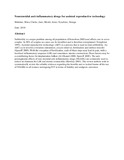| dc.contributor.author | Mahdian, Mina | |
| dc.contributor.author | Clarke, Jane | |
| dc.contributor.author | Moridi, Irene | |
| dc.contributor.author | Nyachieo, Atunga | |
| dc.date.accessioned | 2013-07-11T15:25:54Z | |
| dc.date.available | 2013-07-11T15:25:54Z | |
| dc.date.issued | 2010 | |
| dc.identifier.citation | Nyachieo A, Clarke J, Moridi I, Mahdian M. Nonsteroidal anti-inflammatory drugs for assisted reproductive technology (Protocol). Cochrane Database of Systematic Reviews 2009, Issue 1 | en |
| dc.identifier.uri | http://onlinelibrary.wiley.com/doi/10.1002/14651858.CD007618/full | |
| dc.identifier.uri | http://erepository.uonbi.ac.ke:8080/xmlui/handle/123456789/47614 | |
| dc.description.abstract | Subfertility is a major problem among all populations (Okonofoua 2003) and affects one in seven couples. In 50% of couples no cause can be identified and is therefore unexplained (Templeton 1995). Assisted reproductive technology (ART) is a process that is used to treat subfertility. An ART cycle involves ovulation stimulation, oocyte retrieval, fertilisation and embryo transfer (Speroff 2005). With the exception of fertilisation, each of these steps may lead to pain, with a localized inflammatory response (LIR) and sometimes, uterine contractions.These factors may be a contributing factor for implantation failure (Al-Ghamdi 2008, Speroff 2005).
The anti-prostaglandin effects of non steroidal anti-inflammatory drugs (NSAIDs) are commonly used to reduce or eliminate the LIR and uterine contractility (Hawkey 2003).
The review authors wish to systematically review the reliable evidence regarding the benefits and or indeed harms of the use of NSAIDs in all women undergoing IVF in terms of fertility and analgesic outcomes. | en |
| dc.language.iso | en | en |
| dc.title | Nonsteroidal anti‐inflammatory drugs for assisted reproductive technology | en |
| dc.type | Article | en |
| local.publisher | Department of Biochemistry | en |

